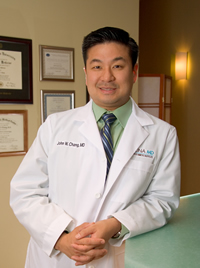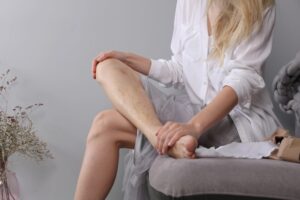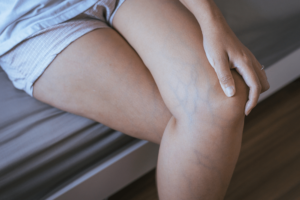Understand Varicose & Spider Vein disease
To understand vein disease, which is the primary cause of varicose veins, it’s first important to understand the venous system of the human body. The venous system is the part of the circulatory system that returns deoxygenated blood through veins back to the heart to be recirculated. By contrast, the arterial system carries oxygenated blood away from the heart to be distributed throughout the body. The smallest parts of the venous system are the capillaries, which feed into larger superficial veins. Two distinct and common complications resulting from venous insufficiency are varicose and spider veins. Both of these progressive conditions create cosmetic concerns and can develop into medical issues.
Varicose Veins or Venous Insufficiency
Varicose veins are enlarged and twisted rope-like veins that appear near the surface of the skin. While they can develop anywhere in the body, they are most  commonly found in the legs and ankles because standing and walking increase pressure in the lower extremities. In normally functioning veins, tiny one-way valves open as blood flows toward the heart and close to prevent blood from flowing backward. When these valves malfunction, blood pools in the veins, resulting in a buildup of pressure that weakens their walls and causes them to bulge. Over time, the increased pressure can cause additional valves to fail. This venous reflux, or venous insufficiency, leads to the development of varicose veins and spider veins.
commonly found in the legs and ankles because standing and walking increase pressure in the lower extremities. In normally functioning veins, tiny one-way valves open as blood flows toward the heart and close to prevent blood from flowing backward. When these valves malfunction, blood pools in the veins, resulting in a buildup of pressure that weakens their walls and causes them to bulge. Over time, the increased pressure can cause additional valves to fail. This venous reflux, or venous insufficiency, leads to the development of varicose veins and spider veins.
Spider Veins

Spider veins (telangiectasias) are similar to varicose veins, but smaller and found closer to the skin’s surface. They take their name from their appearance, which resembles a spider’s web. Usually red or blue in color, they vary in size and can be found in other areas of the body besides the legs, including the face.
Causes of Varicose Vein or Venous insufficiency
Unavoidable underlying causes of chronic venous insufficiency that can lead to varicose veins and spider veins include an inherited genetic predisposition and the normal aging process. Any condition that puts more pressure on leg veins – including standing for long periods of time, being overweight, or pregnancy – can also cause varicose veins or spider veins. Women are at greater risk than men due to hormonal changes that relax vein walls during pregnancy, pre-menstruation or menopause. Birth control pills and hormone replacement therapy may also increase the risk, as do a history of blood clots and conditions that increase pressure in the abdomen, such as tumors, constipation and tight garments like girdles. Other factors include previous venous surgery and exposure to ultraviolet rays.
Symptoms of Varicose Vein
Varicose veins and spider veins appear most commonly between the ages of 30 and 70. The first physical symptom is usually their appearance. As the disease progresses, the legs begin to feel heavy, tired and achy, and these symptoms worsen with prolonged periods of sitting or standing. Muscle cramping may be accompanied by a burning and throbbing feeling in the lower legs. Varicose veins can also cause a change in skin color (known as stasis pigmentation), dry and thinning skin, inflammation of the skin, open sores and bleeding.
Treatment of Varicose Veins & Spider Veins
 As bad as they may look and feel, varicose veins and spider veins are not usually considered a serious medical problem. However, varicose veins may indicate a critical blockage in deeper veins, a condition called deep vein thrombosis, that can be life threatening. Consequently proper medical evaluation and treatment of varicose veins is important. Because chronic venous insufficiency is a progressive disease, symptoms will worsen if left untreated.
As bad as they may look and feel, varicose veins and spider veins are not usually considered a serious medical problem. However, varicose veins may indicate a critical blockage in deeper veins, a condition called deep vein thrombosis, that can be life threatening. Consequently proper medical evaluation and treatment of varicose veins is important. Because chronic venous insufficiency is a progressive disease, symptoms will worsen if left untreated.
The evaluation includes a visual and physical examination of the legs and feet by a physician, who checks for inflammation, areas that are tender to the touch, changes in skin color, ulceration and other signs of skin breakdown. In most cases an ultrasound test is ordered to determine if the valves in the veins are functioning properly and to check for evidence of a blood clot and determine the best approach for curative treatment.
 For decades the only option was an in-hospital surgical ligation and stripping of the veins under general anesthesia. However, new innovations in vein therapies are now available and generally covered by insurance. As an alternative, Miami Veins Institute offers several in-office, less invasive treatments like Endovenous Laser Treatments (EVLT) and Sclerotherapy.
For decades the only option was an in-hospital surgical ligation and stripping of the veins under general anesthesia. However, new innovations in vein therapies are now available and generally covered by insurance. As an alternative, Miami Veins Institute offers several in-office, less invasive treatments like Endovenous Laser Treatments (EVLT) and Sclerotherapy.
These treatments generally take about an hour and you can resume normal activities immediately. If you’re suffering from the pain associated with varicose veins or simply embarrassed by the veins, call 305.446.0440 to set up your complementary, no-obligation physical evaluation.

John W. Dr. Chang, MD, serves as the Partner and Medical Director at Miami Vein Institute, a premier center specializing in vein treatment in South Florida. With a focus on providing high-quality care and ensuring patient safety and satisfaction, Dr. Chang has helped establish Miami Vein Institute as a leading destination for minimally invasive vein treatments. At Miami Vein Institute, Dr. Chang offers a comprehensive range of minimally invasive procedures, including Endovenous Laser Treatments (EVLT) and Sclerotherapy, to address various vein-related concerns. His expertise in both general and cosmetic surgery, combined with specialized training in vein treatments, allows him to tailor treatment plans to meet each patient’s individual needs. Dr. Chang’s commitment to excellence is reflected in his meticulous attention to detail and dedication to staying updated with the latest advancements in vein care technologies. He is certified in a wide array of cosmetic surgery procedures and is a certified trainer for various advanced techniques. Dr. Chang’s affiliations with prestigious medical associations underscore his commitment to upholding the highest standards of medical excellence. With a focus on patient well-being and personalized care, Dr. Chang ensures that every patient receives honest, expert guidance throughout their treatment journey. His passion for providing the best possible care is evident in his commitment to patient satisfaction and achieving optimal outcomes.

